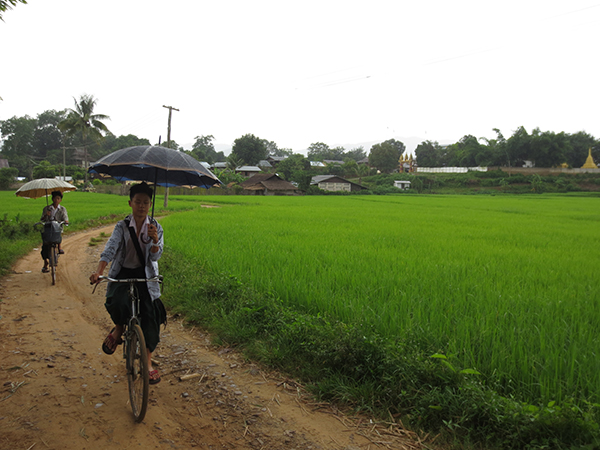Hsipaw
Hsipaw was not originally on my itinerary, but after reading about it, I felt that I just had to squeeze it in.
My bus ride there was more than chaotic, in a good and bad way. First, I somehow managed to be put not on the ordinary bus, but a bus company that was inaugurated that same day. So the bus was brand new (it even had seat-belts!) and we were only 10-15 people on the bus. Also, because it was its first operational day, we received free food and presents. I got a lunchbox that was, as indicated by the packaging, specifically designed for fishermen. I also met a girl, Grace, on the bus who had spent the last four years in Singapore and thus spoke great English. Grace and other people on the bus insisted on buying me sweets at every rest stop. The sweets were typically local specialities of the area we currently were.
The bus ride turned a bit chaotic at 3am. There was an accident between two cars on a small mountain road. Because of that, none of the buses or trucks could pass by. We were standing for five hours until they finally cleared the road. Then we were missing two of our passengers. We finally arrived in Hsipaw with 5.5 hours of delay. As I left, Grace offered me a beautiful bracelet that she had bought in Bagan. At this point, it really seems hard for me to go anywhere without getting gifts. Burmese really are way too kind…
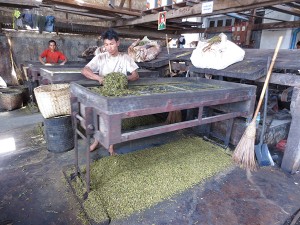 I did not regret my detour to Hsipaw. Unlike all the previous places I had gone to, Hsipaw was a small town (almost a village) that sees significantly fewer tourists. In fact, on my first day in town, I did not encounter any other tourists. I started by just walking around and then visiting a tea factory. I really enjoyed watching them process the tea leaves. The main process was to separate the clumps of leaves into individual pieces. The factory was extremely old and dirty. Right next to it was the mansion of the factory owner. It was a beautiful modern house built out of stone (this is rare in parts of Myanmar) with two Mercedes parked behind the gate (in a country where most cars even lack door handles). Perhaps this wasn’t surprising, but it was still interesting to see the dichotomy between employers and employees.
I did not regret my detour to Hsipaw. Unlike all the previous places I had gone to, Hsipaw was a small town (almost a village) that sees significantly fewer tourists. In fact, on my first day in town, I did not encounter any other tourists. I started by just walking around and then visiting a tea factory. I really enjoyed watching them process the tea leaves. The main process was to separate the clumps of leaves into individual pieces. The factory was extremely old and dirty. Right next to it was the mansion of the factory owner. It was a beautiful modern house built out of stone (this is rare in parts of Myanmar) with two Mercedes parked behind the gate (in a country where most cars even lack door handles). Perhaps this wasn’t surprising, but it was still interesting to see the dichotomy between employers and employees.
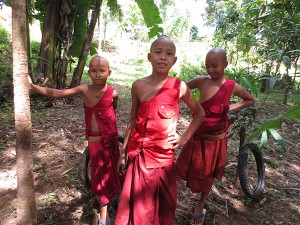 I then went to another monastery where I found three kid monks playing with wheels. Other than that, the monastery was deserted. I have yet to find a monastery with monks…
I then went to another monastery where I found three kid monks playing with wheels. Other than that, the monastery was deserted. I have yet to find a monastery with monks…
Next to it were a few stupa ruins and Mrs Popcorn’s garden. The garden is a small outdoor restaurant with lounge chairs where they offer tamarind/mint tea and fruit salad. Of course, Mrs Popcorn (who also used to make Popcorn before her husband died) brought along all kind of other things I had not ordered.
In the late afternoon, I walked out of town to neighboring villages along the river. On my way, I got to see farmers at work, schoolchildren biking home and beautiful lush rice fields.
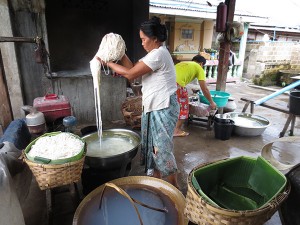 As I walked through the villages, I noticed an ad-hoc noodle factory in someone’s garden. I don’t think this family sees many (any?) tourists. They were delighted to show me around and offered me an absolutely delicious meal of home-made noodles. My final stop for the day was the house of the last Shan prince. The last Shan prince had studied in the US, married an Austrian woman, but was imprisoned once he got back to Myanmar and finally killed in prison. Although the government denies that. His nephew’s wife now occupies the “palace” and welcomes tourists. I enjoyed chatting with her and browsing through old family pictures. Sadly, I did find her a bit too insistent on the donation she demanded for her services.
As I walked through the villages, I noticed an ad-hoc noodle factory in someone’s garden. I don’t think this family sees many (any?) tourists. They were delighted to show me around and offered me an absolutely delicious meal of home-made noodles. My final stop for the day was the house of the last Shan prince. The last Shan prince had studied in the US, married an Austrian woman, but was imprisoned once he got back to Myanmar and finally killed in prison. Although the government denies that. His nephew’s wife now occupies the “palace” and welcomes tourists. I enjoyed chatting with her and browsing through old family pictures. Sadly, I did find her a bit too insistent on the donation she demanded for her services.
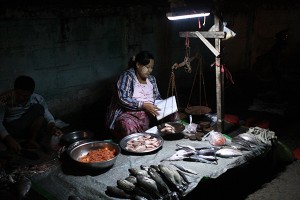 In Hsipaw, there are also worthwhile night sightseeing activities to be done. In fact, there is a candlelight market that goes on from 2am till 6am. Because there are many tribal mountain villages around Hsipaw, a few people come down to town at night, to sell and buy produce. Usually, it is one villager who buys stuff for the whole village that he then loads onto his motorbike and brings back to where he came from. This activity needs to take place at night, because the villagers need to get back to their farmland by dawn to work in their fields. It’s called the candlelight market, because most stalls only use candlelight to lit their products. However, I must say that more and more stalls now also use electric lamps. So I was brave that morning and got up at 3am. The market was fascinating. There was a magical or surreal atmosphere about it. It was amazing to see so much activity in the middle of the night, and all of this happening in the soft candlelight while the rest of the population is sleeping. I also enjoyed watching men and women in tribal clothes leaving on their completely overloaded motorbikes with a million small bags hanging from them. I spent maybe 45min at the market and then went straight back to bed, but it was certainly a highlight of the town.
In Hsipaw, there are also worthwhile night sightseeing activities to be done. In fact, there is a candlelight market that goes on from 2am till 6am. Because there are many tribal mountain villages around Hsipaw, a few people come down to town at night, to sell and buy produce. Usually, it is one villager who buys stuff for the whole village that he then loads onto his motorbike and brings back to where he came from. This activity needs to take place at night, because the villagers need to get back to their farmland by dawn to work in their fields. It’s called the candlelight market, because most stalls only use candlelight to lit their products. However, I must say that more and more stalls now also use electric lamps. So I was brave that morning and got up at 3am. The market was fascinating. There was a magical or surreal atmosphere about it. It was amazing to see so much activity in the middle of the night, and all of this happening in the soft candlelight while the rest of the population is sleeping. I also enjoyed watching men and women in tribal clothes leaving on their completely overloaded motorbikes with a million small bags hanging from them. I spent maybe 45min at the market and then went straight back to bed, but it was certainly a highlight of the town.
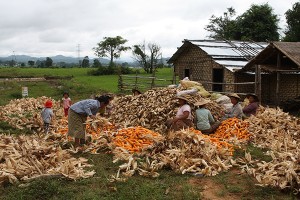 While in Hsipaw, I also went on a 16km hike to a tribal village. We were three people going, two Australians and myself. Of course we also had a guide who coincidentally used to be a Myanmar soccer star. During the trek, we crossed many beautiful rice fields, corn fields, tea plantations, and peanut plantations. We also crossed a few villages, but most villages were deserted as the villagers were probably in the fields. For lunch, we stopped at a village called Pankam which has become somewhat of a tourist attraction, because its elder speaks good English and used to offer home-stays. We stopped at a guesthouse which was really the home of an elderly couple. The meal they cooked for us was one of the best ones I had in Myanmar. They served various vegetable and fruit curries, tea leaf salad and delicious tofu chips. For desert, we just went into their garden and picked some passion fruit off the tree. Of course the meal was served with their own home-grown green tea.
While in Hsipaw, I also went on a 16km hike to a tribal village. We were three people going, two Australians and myself. Of course we also had a guide who coincidentally used to be a Myanmar soccer star. During the trek, we crossed many beautiful rice fields, corn fields, tea plantations, and peanut plantations. We also crossed a few villages, but most villages were deserted as the villagers were probably in the fields. For lunch, we stopped at a village called Pankam which has become somewhat of a tourist attraction, because its elder speaks good English and used to offer home-stays. We stopped at a guesthouse which was really the home of an elderly couple. The meal they cooked for us was one of the best ones I had in Myanmar. They served various vegetable and fruit curries, tea leaf salad and delicious tofu chips. For desert, we just went into their garden and picked some passion fruit off the tree. Of course the meal was served with their own home-grown green tea.
After that, we walked for another two hours, and arrived at our final destination, Taksen. This village is much smaller and sees a lot fewer tourists. The whole village focuses on tea plantations, and the place where we spent the night had its own little tea “factory” in its garden. It was amazing seeing the workers work day (picking the leaves) and night (processing the tea). In addition to the tea plantations, they of course all have other secondary plantations. After another wonderful dinner, we also got to try their home made rice wine and finally, we went outdoors to see the millions of stars that lit the sky. 4-5 villagers from other households were curious about the foreigners in town and stayed with us the whole evening. It was very cute to see them arrive one by bone with their torches and gather at the table next to us. They kept their safe distance, but didn’t really talk among themselves. Instead they starred at us the whole evening with perplexed eyes, and occasionally laughed or smiled at us inquisitively when we started gesturing or speaking enthusiastically about something.
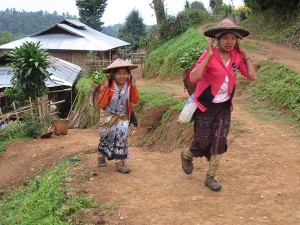 The next morning, I caught a ride back to Hsipaw with a tea leaf delivery boy. This would have been all good and fun if it hadn’t started poring the moment we left the village. Part of the road became small torrents and by the end of the ride, I was totally wet and muddy. One fun part of the ride was to bump into herds of wild/”retired” horses and buffaloes. As these villages use more and more machines to do their farm-work, they have no more use for some of their farm animals. So instead of killing them, they leave them to the wild.
The next morning, I caught a ride back to Hsipaw with a tea leaf delivery boy. This would have been all good and fun if it hadn’t started poring the moment we left the village. Part of the road became small torrents and by the end of the ride, I was totally wet and muddy. One fun part of the ride was to bump into herds of wild/”retired” horses and buffaloes. As these villages use more and more machines to do their farm-work, they have no more use for some of their farm animals. So instead of killing them, they leave them to the wild.
All in all, Hsipaw was well worth the detour! I wish I could have stayed longer!!
See more pictures here.
Practical infos: There is a direct bus from Inle Lake to Hsipaw which is not indicated in any of the guidebooks. Also, when in Hsipaw, stay at Lily’s guesthouse. Lily is incredibly kind and will do everything to accommodate you. The alternative would be Mr. Charles guesthouse which is really not so good.
This entry was posted on Wednesday, December 11th, 2013 at 6:19 am and is filed under Travel Stories. You can follow any responses to this entry through the RSS 2.0 feed.
